1996 PONTIAC BONNEVILLE engine
[x] Cancel search: enginePage 196 of 387
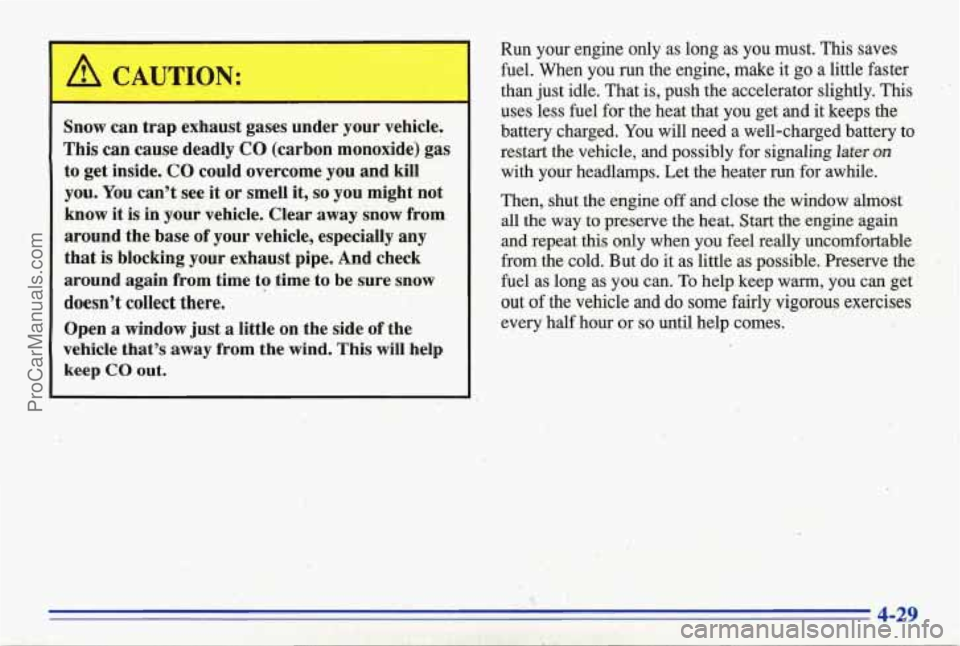
_I .
-- 1. <. i - .
A CAUTION:
Snow can trap exhaust gases under your vehicle.
This can cause deadly CO (carbon monoxide)'gas
to get inside. CO could overcome you and kill
you. Youxan't see
it or smell it, so you might not
~QW it is in your vehicle. Clear away snow from
around the base of your vehicle, especially any
that is blocking your exhaust pipe. And check
around again from time to time to be sure snow
doesn't
collect there.
Open
a window just a little on the side of the
vehicle
that's away from the wind. This will help
keep CO out.
Run your engine only as long as you must. This saves
fuel. When you run the engine, make it
go a little faster
than just idle. That is, push the accelerator slightly.
This
uses less fuel for the heat that you get and it keeps the
battery charged. You will need a well-charged battery to
restart the vehicle, and possibly for signaling
later OIZ
with your headlamps. Let the heater run for awhile.
Then, shut the engine
off and close the window almost
all the way to preserve the heat. Start the engine again
and repeat
this only when you feel really uncomfortable
from the cold. But do it as little as possible. Preserve the
fuel as long as you can.
To help keep warm, you can get
out of the vehicle and do some fairly vigorous exercises
every half hour or so until help comes.
4-29
a. . ProCarManuals.com
Page 199 of 387
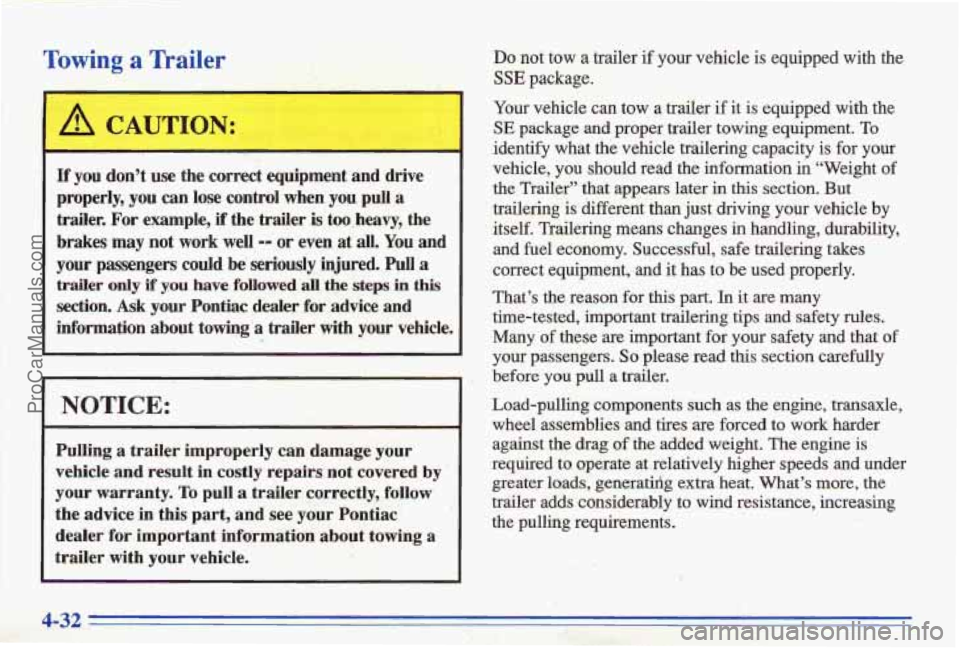
Towing a Trailer
If you don’t use the correct equipment and drive
properly,
you can lose control when you pull a
&der. For example, if the trder is too,heavy, the
brakes
may not work well -- or even at all. You and
your passengers could be’ seriously injured. Pull a
trailer only if you have followed all the steps in this
section. Ask your Pontiac dealer for advice and
information about towing
a trailer with your vehicle.
’ I NOTICE:
~
Pulling a trailer improperly can damage your
vehicle and result in costly repairs not covered by
your warranty.
To pull a trailer correctly, follow
the advice in this part, and see your Pontiac
dealer- for important information about towing a
trailer
with your vehicle.
Do not tow a trailer if your vehicle is equipped with the
SSE package.
Your vehicle can tow a trailer if it is equipped with the
SE package and proper trailer towing equipment. To
identify what’the vehicle ‘trailering capacity is for your
vehicle, you should read the information i.i “Weight of
the Trailer” that appears
later in this section. But
trailehg is different
than just driving your vehicle by
itself. Trailering means changes
in handling;durability,
and fuel economy. Successful, safe trailering takes
correct equipment, and it has
to be used properly.
That’s
the reason for this part. In it are many
time-tested, important trailering tips and safety rules.
Many of these are important for your safety and that of
your passengers. So please read this section carefially
before
you pull a trailer.
Load-pulling_components
such as the engine, transaxle,
wheel assemblies
and tires are forced to work harder
against
the drag of the added weight. The engine is
required to operate at relatively higher speeds and under
greater
loads, generatkig extra heat, What’s more, the
trailer adds considerably to
wind resistance, increasing
the pulling requirements, -
4-32 ‘
.. ProCarManuals.com
Page 200 of 387
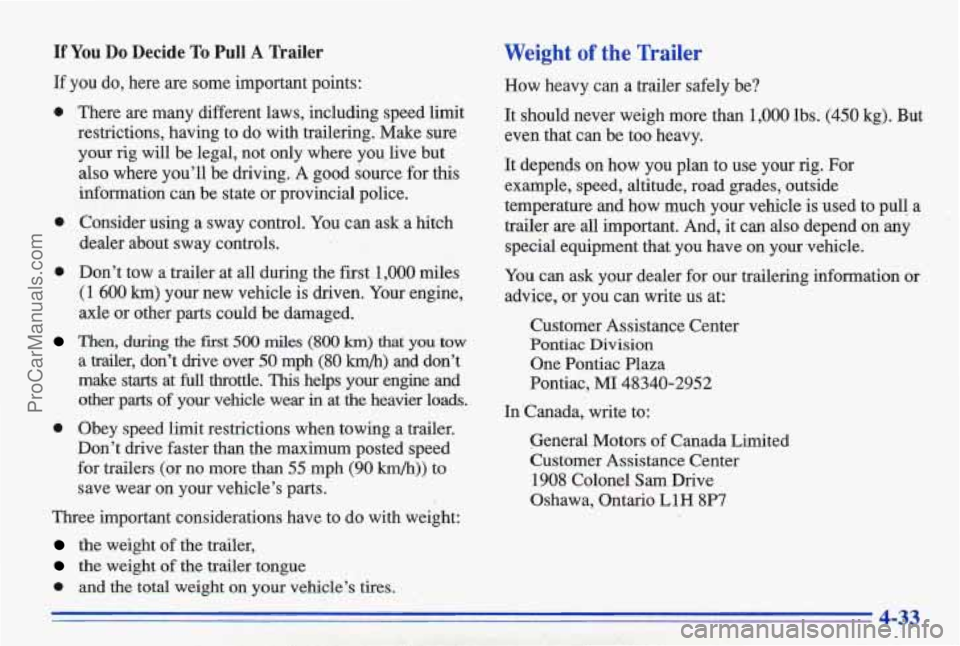
If You Do Decide To Pull A Trailer
If you do, here are some important points:
0
0
0
0
There are many different laws, including speed limit
restrictions, having to do with trailering. Make sure
your rig will be legal, not only where you.live but
also where you’ll be driving.
A good source for this
information can be state or provincial police.
Consider using a sway control. You can ask a hitch
dealer about sway controls.
Don’t tow a trailer at
all during the first 1,000 miles
(1 600 h) your new vehicle is driven. Your engine,
axle or other parts could be damaged.
Then,
during the first 500 miles (800 km) that you tow
a trailer, don’t drive over 50 mph (80 km/h) and don’t
make
starts at full throttle. This helps your engine and
other
parts of your vehicle wear in at the heavier loads.
Obey speed limit restrictions when towing a trailer.
Don’t drive faster than the maximum posted speed
for trailers
(or no more than 55 mph (90 km/h)) to
save wear on your vehicle’s parts.
Weight of the Trailer
How heavy can a trailer safely be?
It should never weigh more than
1,000 lbs. (450 kg). But
even that can be too heavy.
It depends on how you plan to use your
rig. For
example, speed, altitude, road grades, outside
temperature and how much your vehicle is used to pull, a
trailer are all important. And, it can also depend
on any
special equipment that you have on
your vehicle.
You can ask your dealer for our trailering information or
advice, or you can write us at:
Customer Assistance Center
Pontiac Division
One Pontiac. Plaza
Pontiac,
MI 48340-2952
In ‘Canada, write to:
General Motors of Canada Limited
Customer Assistance Center
1908 Colonel Sam Drive
Oshawa, Ontario
L1H 8P7
Three important considerations have to do with weight:
the weight of the trailer, = .\,
the weight of the trailer tongue
d ,and the total weight on your vehicle’s tires.
.hi. .+ . ,.
.. . -’ Y
ProCarManuals.com
Page 204 of 387
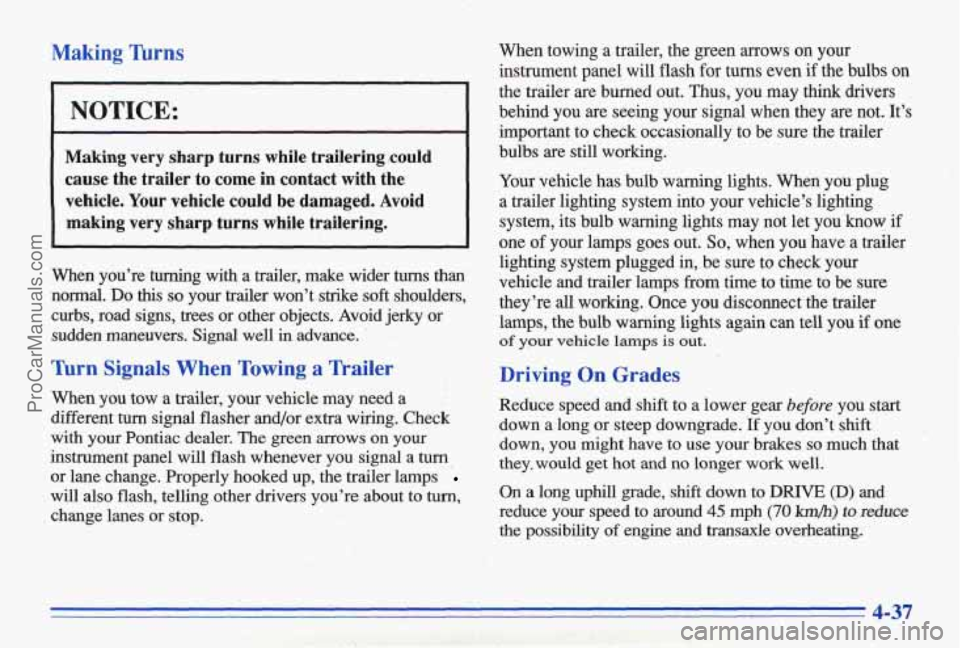
Making Turns
NOTICE:
Making very sharp turns while trailering could
cause the trailer to come in contact with the
vehicle. Your vehicle could be damaged. Avoid
making very sharp turns while trailering.
When you’re turning with a trailer, make wider turns than
normal. Do this so your trailer won’t strike soft shoulders,
curbs, road signs, trees or other objects. Avoid jerky
or
sudden maneuvers. Signal well in advance. ‘
. Turn ,Signals When Towing a Trailer’
When you tow a trailer, your vehicle may need a
different
turn signal flasher and/or extra wiring. Check
with your Pontiac dealer. The green
arrows on your
instrument panel will flash whenever you signal a turn
or lane change. Properly hooked up,’ the trailer lamps
will also flash, telling other drivers you’re about to turn,
change lanes or stop. When towing a trailer, the green arrows
on your
instrument panel will flash for turns
even if the bulbs on
the trailer are burned out.
Thus, you may think drivers
behind you are seeing your signal when they are not. It’s
important to check occasionally to be sure the trailer
bulbs are still working.
Your vehicle has bulb warning lights. When you’plug
a trailer lighting system into your vehicle’s lighting
system, its bulb warning lights may not let you
know if
one of your lamps goes out. So, when you have a trailer
lighting system plugged in, be sure to check your
vehicle and trailer lamps
from time to time to be sure
they’re
all working. Once you disconnect the trailer
lamps, the bulb warning lights again can tell you
if one
of ypur vehicle lamps is out.
Driving On Grades
Reduce speed and shift to a lower gear before you start
down a long or steep downgrade.
If you don’t shift
down, you might have to use your brakes so much that
they. would get hot
and no longer work well.
On a long uphill grade, shift down to Dm (D) and
reduce your speed to around
45 mph (70 km/h) to reduce
the possibility of engine and transaxle overheating.
4-37
ProCarManuals.com
Page 205 of 387
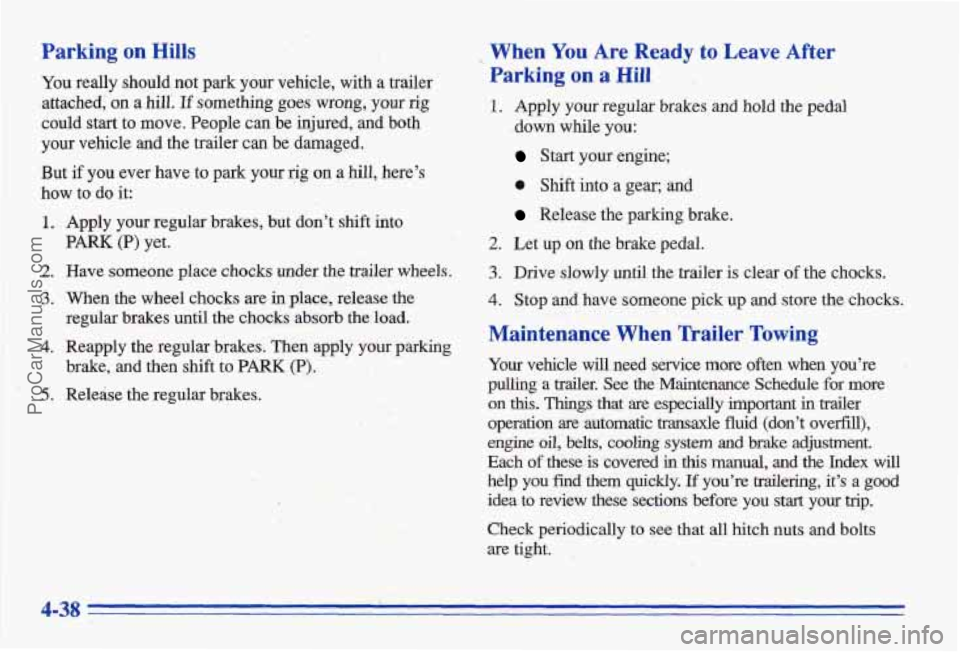
Parking on Hills
You really should not park your vehicle, with a trailer
attached,
on a hill. If something goes wrong, your rig
could start to move. People can be injured, and both
your vehicle and the trailer can be damaged.
But
if you ever have to park your rig on a hill, here’s
how to do it:
1. Apply your regular brakes, but don’t shift into
2. Have someone place chocks under the trailer wheels.
3. When the wheel chocks are in place, release the
regular brakes
mil the chocks absorb the load.
4. Reapply the regular brakes. Then apply your pa;rking
brake, and then shift to PdRK (P).
PARK (P) yet.
’ 5. Release the regular brakes.
~ When You Are Ready to Leave After
Parking on a Hill
1. Apply your regular brakes and hold the pedal
.down while
you:
Start your engine;
e Shift into a gear; and
Release the parking brake.
2. Let up on the brake pedal.
3. Drive slowly until the trailer is clear of the chocks.
4. Stop and have someone pick up and store the chocks.
Maintenance When Trailer Towing
Your vehicle will & service more often when you’re
pmg a trde~ See the Mainte~nance Schedule for more
on this. Things that are especially important in trailer
operation are .automatic
trande fluid (don’t overfill),
engine
oil, belts, cooling system and brake adjustment.
Each
of these is-covered in this manual, and the Index will
help you kd them quickly. If you’re tradering, it’s a good
idea to review these sections before you start your trip.
Check periodically to see that all hitch nuts and bolts
are tight.
4-38
ProCarManuals.com
Page 208 of 387
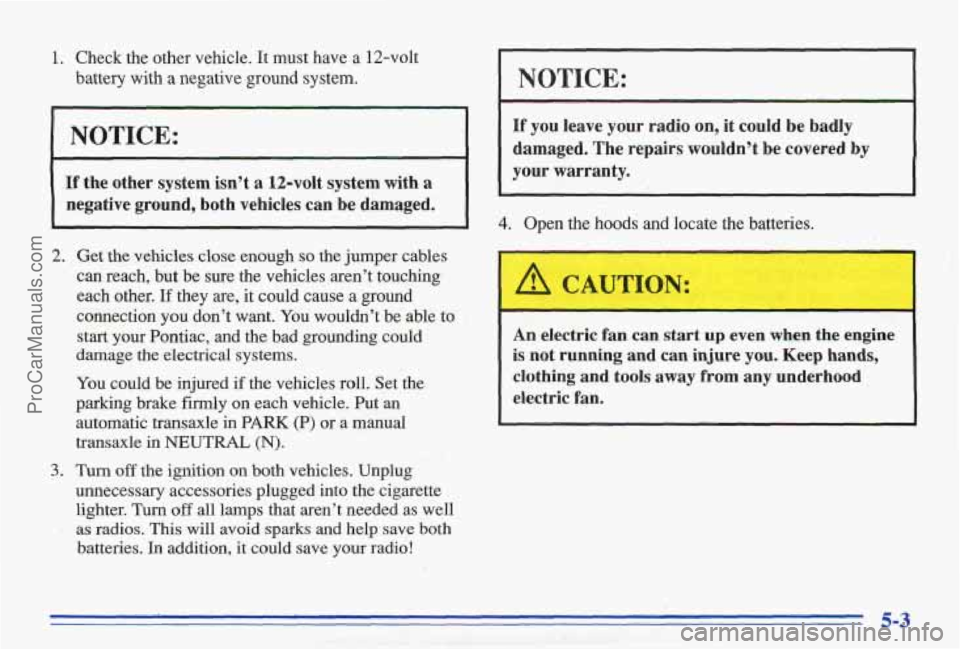
1. Check the other vehicle. It must have a 12-volt
battery with
a negative ground system.
NOTICE:
If the other system isn’t a 12-volt system with a
negative ground, both vehicles can be damaged.
2. Get the vehicles close enough so the jumper cables
can reach, but be sure the vehicles aren’t touching-
each other.
If they are, it could cause a ground
connection you don’t want. You wouldn’t be able
to
start your Pontiac, and the bad grounding could
damage the electrical systems.
You could be injured
if the vehicles roll. Set the
parking brake firmly on each vehicle. Put an
automatic transaxle in PARK (P) or a manual
transaxle
in NEUTRAL (N).
3. Turn off the ignition on both vehicles. Unplug
unnecessary accessories plugged into the cigarette
lighter. Turn
off all lamps that aren’t needed as well
I as radios. This will avoid sparks and help save both
batteries. In addition, it could save your radio!
NOTICE:
If you leave your radio on, it could be badly
damaged.
The repairs wouldn’t be covered by
your warranty.
4. Open the hoods and locate the batteries.
An electric fan can start ~ even wl 3 the engine
is not running and can injure you. Keep hands,
clothing and tools away
from any underhood
electric fan.
5-3
ProCarManuals.com
Page 209 of 387
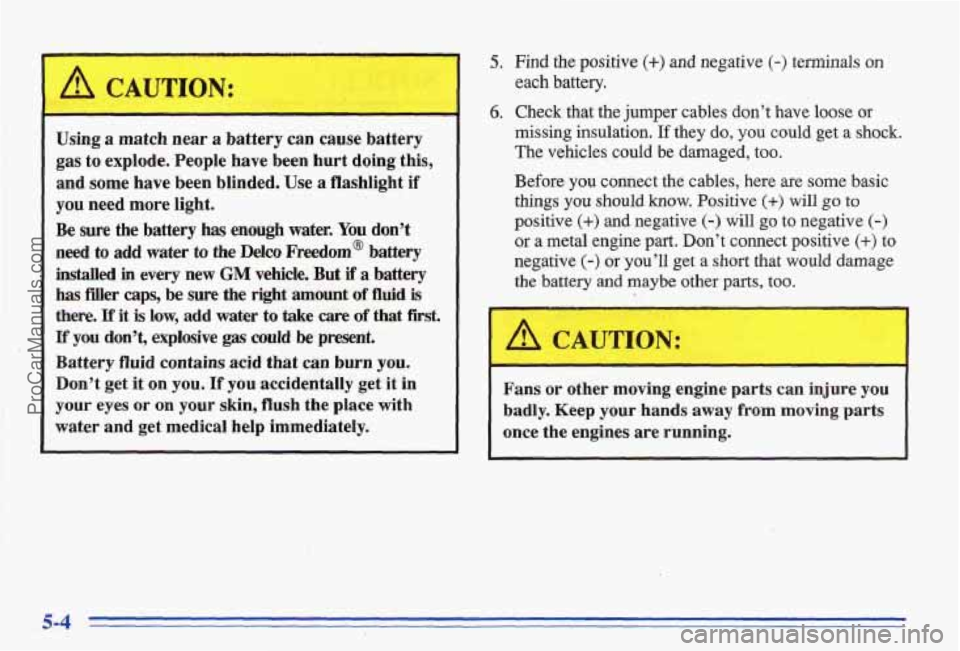
Using a match near a battery can cause battery
gas to exp1ode:People have been hurt doing this,
and some have been blinded. Use a flashlight
if
you need more light.
Be
sure the battery has enough water. You don’t
need to
add water to the Deko Freedom@ battery
installed
in every new GM vehicle, But if a battery
has filler caps, be sure the right mount of fluid is
there. If it is low, add water to take care of that first.
If you don’t, explosive gas could be present.
Battery fluid contains acid that can burn
you,
Don’t get it on you. If you accidentally get it in
your eyes
or on your skin, flush the place with
water and get medical help immediately.
5. Find the positive (+) and negative (-) terminals on
6. Check that the jumper cables don’t have loose or
each
battery.
missing insulation. If they do, you
could get a shock.
The vehicles could be damaged, too.
Before
you connect the cables, here are some basic
things you should know. Positive (+) will go to
positive (+) and negative (-) will go to negative (-)
or a metal engine part. Don’t connect positive (+)’ to
negative (-) or you’ll get a short that would damage
the battery and maybe other parts, too.
A CAUTION: I .
m Fans or other moving engme parts can injure yon
badly. Keep your hands away from moving parts
once the engines are running.
5-4
ProCarManuals.com
Page 211 of 387
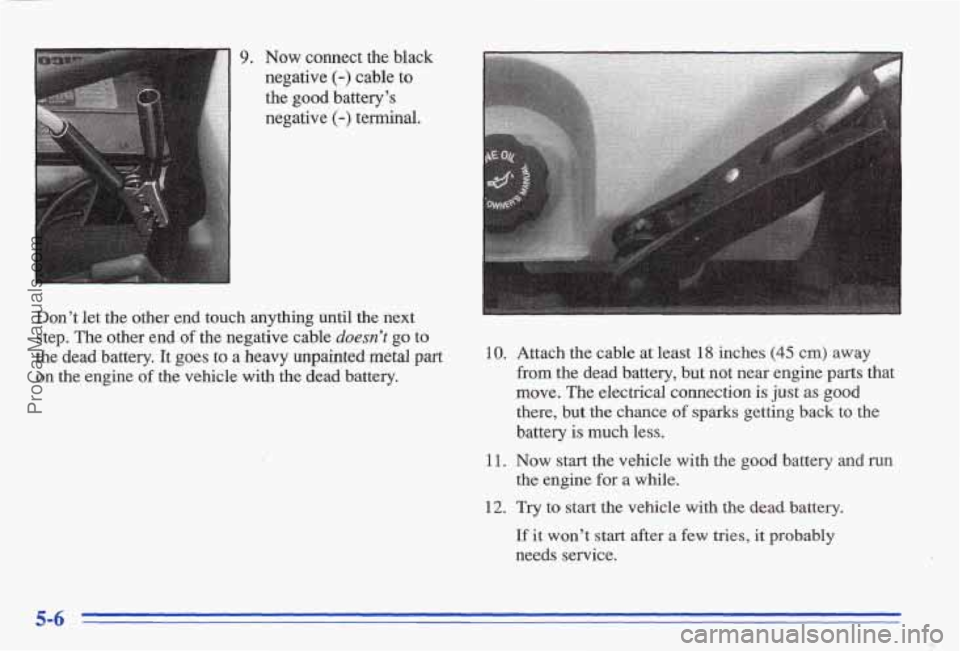
9. Now connect the black
negative
(-) cable to
the good battery’s
negative
(-) terminal.
Don’t let the other end touch anything until the next step. The other end of the negative cable
doesn’t go to
the dead battery. It
goes to a heavy unpainted metal part
on the engine of the vehicle with the dead battery.
10. Attach the cable at least 18 inches (45 cm) away
from the dead battery, but not near engine parts that
move. The electrical connection
is just as good
there, butthe chance of sparks getting back to the
battery
is much less.
11. Now start the vehicle with the good battery and run
12. Try to start the vehicle with the dead battery.
the engine
for a while.
If it won’t start
after a few tries, it probably
needs service.
5-6
ProCarManuals.com